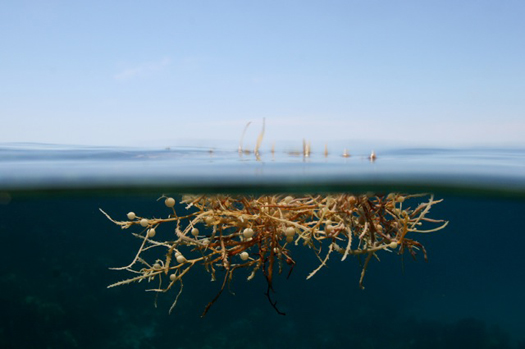Mission Blue supporter Richard Rockefeller reports: Light winds, clear skies, a leisurely agenda and frequent laughter belie this group’s intensity of purpose. We are a collection of TEDsters, Bermudian government officials, scientists, media folk, and of course, Dr. Sylvia Earle, 2009 TED Prize Winner — spending a few days in the azure waters of the Sargasso Sea, the “golden floating rainforest of the sea,” as Sylvia has called it. On a mini version of April’s TED Mission Blue Voyage in the Galapagos, we are here to learn about the mysteries of the Sargasso Sea — another of Sylvia’s “hope spots” — and its critical value to life on earth. And we are here to help protect the entirety of it — more than a million square kilometers — if we can.
We motor out over the shallow — and healthy-appearing, I’m happy to report — reefs of the Bermuda Bank, through islands and strands of viscid, exotic smelling, light grey and pink coral spawn, which we photograph and collect in paper cups for closer examination. The spawn is often clumped together with lacy yellow Sargasso weed, or Sargassum, which spawns, in turn, endless puns about the ocean’s “sargasms,” etc.
Sargassum is named for the Sargasso Sea, a huge gyre created and bounded by the four great currents of the Atlantic Ocean. The weed often appears in patches as large as football fields, but the ones we encounter today are much smaller -– squash-court sized, at most — as the tail of Hurricane Danielle disrupted the big ones a few days ago. It looks pretty from the deck of our boat, truly golden against the deep ocean blue, but from this distance, not so very interesting after the first few patches. It is only when you get up close that the intricate structure of pea-sized air sacs on top, which keep it afloat, combined with a complex web work beneath, begin to suggest deeper secrets.
Sargassum, and the enormous sea from which the name derives, comprise an extraordinary and unique ecosystem. It not only harbors many creatures found nowhere else, it serves as an essential breeding ground and nursery to many of the species — eels and bluefin tuna, among others — that grace the waters and shores of the entire Atlantic Ocean.
Snorkeling among the weed hints more clearly at this diversity, as baby flying fish skip away across the water’s surface and comma-sized items zip among the weedy strands, too fast for these aging eyes, at least, to follow. We get a clearer view when Chris Flook, Collector of Specimens and Bermuda Lionfish Project Coordinator at the Bermuda Aquarium Museum and Zoo, comes alongside our boat and gives us a close-up view of the astonishing variety found in only a few scoops of Sargassum: baby puffers, needlefish, triggerfish, bonito and the well-disguised and rather cuddly-looking but voracious Sargassum fish. Each baby Sargussum fish, or “critter” as Sylvia calls them, is a little fingernail-sized but completely recognizable version of the adults we know.
We need to protect this incredible resource from harvesting, overfishing, dumping and other human abuse and negligence, and we need to do it soon. Compared to other large, high-seas protection efforts, this one may be relatively easy.
And as such, we hope that the completion of this conservation effort will set an example for others to follow in short order.
On Monday here in Bermuda, we kicked off our Sargasso Sea expedition by celebrating Sylvia Earle’s 75th birthday. You don’t need to know Sylvia personally to know what she wished for as she blew out the candles on her cake (a flour-and-sugar diorama of the Sargasso Sea, of course) surrounded by friends and colleagues. The wish is one that TED seeks to grant in honoring her with the TED Prize, a wish big enough to change the world.
Join us in granting Sylvia’s wish through the Mission Blue campaign -– and do your part to save the seas.
These gorgeous photos come from LookBermuda


Comments (1)